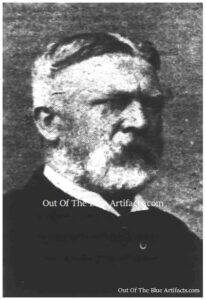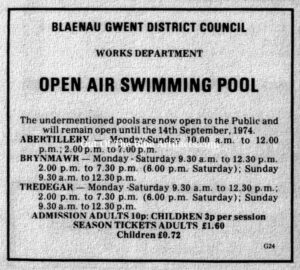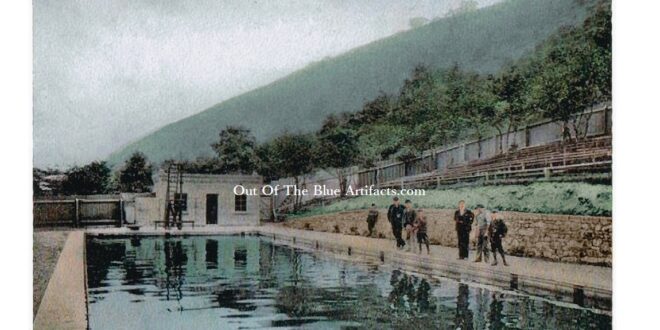Abertillery Park Outdoor Swimming Baths.
An outdoor swimming baths at Abertillery Park was first proposed by Mr Arthur Tilney, Councillor of Abertillery. In the late 1890’s, Mr Tilney put his ideas to the council for consideration. Following is a brief story of his fight for, and the construction of, the outdoor swimming baths for the people of Abertillery.
Following is a Link to – Mr Arthur Tilney.
The Council Meeting and Proposal.
On Monday 8th of August 1898, a council meeting was held at the Abertillery Offices where Mr W. Stewart presided, those present were as follows – Mr W. Davies; Mr A. Tilney; Mr W. Thomas; Mr C. W. Carpenter; Mr D. Lewis; Mr W. P. Davies; Mr J. T. Williams; Mr W. P. Thomas; Mr E. J. Williams; Mr J. Wallace; Mr T. J. Buckley; Mr W. Jones; Mr G. Gregory; Mr Moses Adams; Mr C. B. Cook; Mr J. Alex Shepard (Clerk); Mr McBean (Surveyor) and Mr Padfield (Inspector of Nuisances):
The South Wales Gazette reported on the council meeting on the following Friday, the 12th of August 1898 – A Proposed Swimming Baths for Boys. Mr Tilney moved as follows – “A pond be dug at the top end of the park and that swimming be allowed therein subject to the supervision of the school attendance officers after 2.00pm on Fridays”. Mr Tilney referred to the difficulty of getting children to attend school on the afternoons of Fridays and advocated the formation of swimming lessons which could be included in the school’s curriculum and that the council could appoint a swimming master.
Mr Tilney also said that he did not intend that the baths be looked upon as a permanent swimming bath if a better one could be obtained. He contended that the pond should not be deeply dug and should be done in an informal manner. In wintertime, the pond could be used for skating. Other members of the council wanted an indoor swimming bath on ground adjoining the new workmen’s institute but stated that the ideas came at an inopportune time, Mr C. W. Carpenter suggested that Mr Tilney should consider the question for the following year and to prepare a scheme, as the present time was impracticable.
Permission Granted.
In April 1899, Mr Tilney was given the go-ahead to commence work on the construction of the swimming baths. A site was chosen at the top end of the park close to a natural spring on Blaina Road. The council had given permission for the open-air baths to be built but refused to fund the work from the rates. Councillor Mr Arthur Tilney, the founder of the scheme, stated he would raise the necessary money himself and would set up a “Penny Fund” for the bath’s construction works. Originally, admission to the open-air baths was intended to be free, it was Mr Arthur Tilney’s gift to the children of Abertillery and area.
Mr Ford’s Travelling Fair.
Mr Tilney at this time, was a timber merchant, his sawmills were opposite the Railway Inn, Abertillery, on ground later occupied by the Pavilion Theatre and the Empress Skating Rink, later cinema. The area around the mills was his grounds and was used for various football matches, exhibitions and fairground attractions etc. Mr Tilney arranged for “Mr Ford’s Travelling Fair” to come to his grounds, the special attraction was “Mr Ford’s Steam Horses” all money raised from this attraction would go into the swimming baths fund.
Construction Work.
To enable this project of the swimming pool to go ahead, Mr Tilney set up a committee for the finance and construction work. The committee was – Mr A. Tilney, (Manager); Mr Samuel Nathan Jones J.P. (Treasurer); Mr Ernest D. Tilney, (Secretary) and Mr James McBean the Abertillery Council Surveyor: The committee wanted five-hundred strong boys to volunteer to cut one yard of earth each! The tools would be provided by the committee.
The Cutting the Sod Ceremony.
On Monday 24th of April 1899, the first sod was cut for the Abertillery Swimming Baths. Over five-hundred people came out to help and witness the spectacle. Mrs Annie Tilney cut the first sod and the construction work began.
In May 1899 during a council meeting, the issue of a council workman working on the open-air swimming baths was brought up and Mr Tilney was warned for having council staff working for him when they were in the employ of the council. In reply, Mr Tilney said the gentleman in question had only wanted to help. Mr Buckley jumped to the defence of Mr Tilney and said – “Every council member should treat Mr Tilney with courtesy for the work he does in this valley”. During research I found the Mr Tilney had indeed worked hard, very hard for the council in getting what he thought best for the residents of Abertillery, though sadly many of the council members put every possible obstacle in his way and didn’t want to compliment him or publicly recognise his many achievements.
Description of the Swimming Baths.
In August 1900 the swimming baths had been finished but not open to the public. The water for the swimming baths came from the number 3 reservoir on the mountain side, just above Old Blaina Road, close to what is now Cyril Place. The baths sides were made from brick with a concrete bottom. The size of the baths was 92′ feet in length and 30′ feet in width, the water was 7′ feet deep at the deepest end, rising to about 4′ feet at the shallowest end. Owing to its position it was a natural gallery and was capable of seating 2,000 spectators. The whole area was enclosed by zinc sheets. The park-keeper was Mr J. Kidner, he reported to the council he was keeping an eye on the baths as there were a spate of stone throwers causing a nuisance.
 The Official Opening of the Swimming Baths.
The Official Opening of the Swimming Baths.
On Monday 3rd of September 1900, at 4.00pm in the afternoon the Abertillery Swimming Baths was officially opened, the opening ceremony was presided by Mr Daniel Lewis Esq J.P. the chairman of the Abertillery Council. Councillor Mr Daniel Lewis (as seen left) was the general manager of the Cwmtillery and Rose Heyworth Collieries combine under Messrs J. Lancaster & Co, living at Lake Villa’s, Cwmtillery.
The entertainment was provided with a series of swimming races held by the Newport Swimming Club, some names – Mr J. Fletcher; Mr W. Padfield; Mr W. Davies; Mr J. Ashman; Mr C. Plewett; Mr W. Thomas and Mr Edward Clutson:
The Newport Club handicap featured Mr J. Brickley; Mr E. Goldsmith; Mr H. E. Turner; Mr W. H. Thompson; Mr H. A. Pritchard and Mr H. H. Witts;
A Polo Match was competed over by teams from Newport – Herbert’s Team, Mr H. J. Herbert (Capt); Mr J. Westlake (Goal); Mr W. H. Witts, Mr W. W. Hewertson (Backs); Mr C. H. Wilson, Mr H. E. Turner and Mr E. Goldsmith (Forwards): Mr Dickson’s Team, Mr R. J. B Dickson (Capt); Mr W. C. Purnell (Goal); Mr J. Brickley and Mr W. E. Freeguard (Backs); Mr C. J. Cartmall, Mr W. H. Thompson and Mr W. H. Thompson (Forwards): The Referee was Mr Ernest Richards.
Later in the afternoon there was an exhibition of “Scientific Swimming” given by Mr Ernest Richards N.S.C. (Winner of the English Championship 1897). Mr Richards was awarded a medal for his display on the day.
Mr Charles Clay.
Later a “Greasy Pole” competition was held, a long greasy pole was positioned over the water and a prize was given to anyone who could walk across without slipping into the water. No-one was able to do it though Mr Charles Clay of Abertillery, with only one arm, made his way the furthest and was awarded the prize.
To finish off the day, a men’s race was held at the sports ground, the first prize was a pair of boots awarded by Mr Witchell to the winner Mr W. John, the second-place prize of a box of chocolates went to Mr J. Ralph. The Sports Committee and its Secretary Mr J. Buckley were congratulated for their excellent efforts.
Mr Stephens.
In May 1901 Mr Stephens was appointed superintendent at the Abertillery Park Baths. The entrance fee was 2d. which included a towel and bathing apparel.
Attendance Figures.
On Friday 31st of May 1901, the South Wales Gazette reported that on the previous Monday 27th of May (Spring Bank Holiday) nine hundred people passed through the bath’s enclosure.
New Baths and Extension.
In January 1936 the Abertillery Council put forth plans to renovate and extend the Abertillery Park Baths at a cost of £3,000. Plans for the baths were prepared by Mr A. Gordon Jones (Council Surveyor).
On Friday 31st of January 1936, the Way’s and Means Committee issued a report of the new baths project, it stated the tenders received for the completion of – Extension and Improvement of the Baths and Buildings etc and a Chlorination and Filtration Plant. The tenders were opened and the lowest tender accepted was by Messrs J. E. Jones & Co Ltd of Pontllanfraith at a figure quoted £1,912. 9s. 6d. This tender was proposed by Mr D. Walters and seconded by Mr G. H. Jones.
The surveyor referred to the appointment of a clerk of the works and appointed Mr H. Collard, a temporary technical assistant engaged upon the planning. The costs of ammoniator, gasmasks and baths brushes amounted to £744. The lowest tender for the cost of driving the baths plant based upon the electricity manager’s estimated price of 2d. per unit was taken by Messrs Pulsometer Engineering Co Ltd of Reading. This tender was proposed by Mr Saunders and seconded by Mr Hardwick.
In May 1936 the electricity works supplied electricity to the baths with a three-phase line at a cost of £400. The lines went from an extension off Bridge Street and up Old Blaina Road to the swimming baths.
The Official Opening of the new Abertillery Baths.
On Monday 10th of August 1936, the new enlarged Abertillery Outdoors Baths was officially opened by Captain Geoffrey Crawshay, the district commissioner. It was paid for by a grant from the Special Areas Fund. Mr William Beynon the chairman of the Abertillery District Council presided.
Following the speeches, a programme of aquatics commenced, exhibitions were given by members of the Powell’s Tillery Swimming Club including Mr J. Musselwhite; Mr R. Hoskins; Mr G. Samuel; Mr R. Rees; Mr R. Jones; Mr C. Cook; Mr T. Holman; Mr A. Young; Mr J. Lewis; Mr A. Williams; Miss B. Landon and Miss E. Morgan: Mr B. Samuel (Secretary of the Powell’s Tillery Club) organised the events and Mr Ronald Green (Baths Supervisor) was the M.C.
Description of the New Swimming Baths.
After the new extension the surface area of the new swimming baths was now 92′ feet by 43′ feet. There were 20 male cubicles and 13 female cubicles. Showers, foot baths and conveniences for both sexes had also been installed. There was a filtration plant capable of turning the water over in six hours. The swimming baths water capacity was now 125,000 gallons. Other features were a new tubular diving stage, a springboard, scum troughs, gala lanes and also sunbathing facilities. The filtration plant cost £700 and the other work cost £2,300.
Mr Ronald Green.
In 1936 Mr Ronald Green was appointed superintendent at the Abertillery Park Baths.
Mr Reg Jones.
From the early to mid 1950’s Mr Reg Jones was the swimming instructor at the Abertillery Park Baths. He retired in April 1956.
Mr Geraldus “Gral” Samuel.
In May 1956 Mr Geraldus “Gral” Samuel was appointed superintendent at the Abertillery Park Baths.
The Park Baths and the Rhiw Colbren Waste Tip Concern.
On Friday 15th of September 1967, there were calls for the park baths to be closed the South Wales Gazette printed a letter sent to the Abertillery Council from a concerned resident who feared for the safety of the swimmers at the park baths with concerns of the movement of the nearby Rhiw Colbren Colliery waste tip. The resident’s attention was drawn to the tip after the Aberfan disaster of 1966, and the concerned resident did not want to see another similar incident at the park baths.
The tip in question was just north of Cyril Place on Old Blaina Road, a part of Rhiw Colbren Colliery on land owned by the Pontypool Park Estate. Two councillors refused to close the baths as they were reassured that the tip was safe. It was stated that the tip had slipped as early as 1943 and Old Blaina Road had been closed, it was still closed at the time of this report in 1967 even though the N.C.B. had examined the tip in the past few years and stated that it was stable with no imminent dangers.
Drainage System on the Waste Tip.
On Friday 29th of March 1968, after another concerned resident voiced their fears over the waste tip the council said they would ask the National Coal Board’s tip control unit to examine the tip and a drainage system was to be introduced.
The New Sports Centre Abertillery.
On Friday 15th of March 1974, the new Abertillery Sports Centre was constructed on the site of the old Vivian Colliery, close to Vivian Street, Abertillery. The new centre included two indoor swimming pools, one adult and one children’s pool, after its opening, the outdoor pool at the park was kept open for a while though began to fall into a state of disrepair.
 The Opening Times and Price List.
The Opening Times and Price List.
In July 1974, the Gwent Gazette printed opening times and price list for the outdoor baths at Abertillery Park. The list (as seen right) states the baths were open Monday to Sunday 10.00am to 12.00pm and 2.00pm until 7.00pm. Admission costs were -Adults 10p and Children 3p per session. Season Tickets were Adults £1.60 and Children £0.72p.
The Retirement of Mr Geraldus “Gral” Samuel.
On Friday 19th of December 1975, the Gwent Gazette printed the story of Mr Samuel who was to retire at the end of that year. It stated that he was employed at the new Sports Centre although still worked as superintendent at the outdoor pool during the summer, where he was helped by his grand-daughter Miss Jacqueline Nelms.
Council Service Cutbacks.
On Friday 19th of July 1976, the Gwent Gazette reported on the leisure and amenities service cuts by the Blaenau Gwent Borough Council. It was stated that a twelve month closure of the outdoor swimming pool at Abertillery would reduce the expenditure by £3,850.
Closure of the Abertillery Park Baths.
In July 1976 the Blaenau Gwent Council’s Leisure Committee agreed to keep the Abertillery Park Baths closed for the coming season because of financial difficulties and vandalism to the baths building during the past winter. After a site meeting, attended by local councillors it was agreed that the pool would not open this year and that it should be drained of water and the buildings secured and patrolled by park attendants.
The Later Years.
The old baths at the park were left to decay and was later demolished and is now covered over with plant growth, nothing has ever been built on its site.
Sources – The South Wales Gazette and the Gwent Gazette.
 Out Of The Blue Artifacts A Library of a lifetime of collecting
Out Of The Blue Artifacts A Library of a lifetime of collecting
